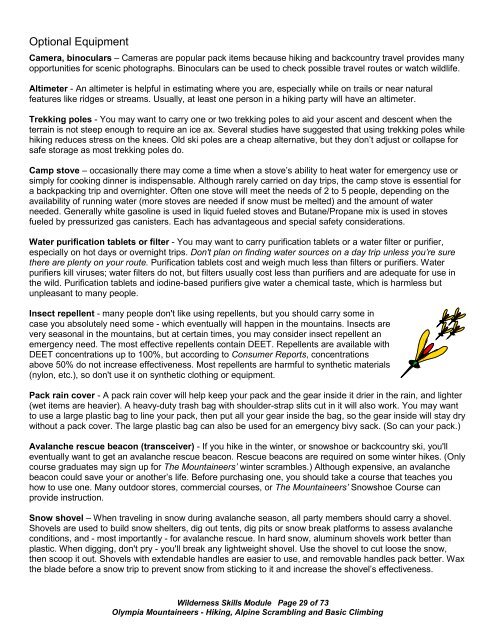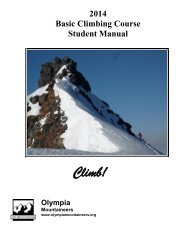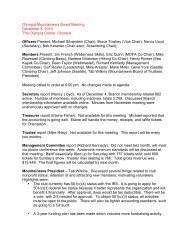Wilderness Skills - Olympia Mountaineers
Wilderness Skills - Olympia Mountaineers
Wilderness Skills - Olympia Mountaineers
You also want an ePaper? Increase the reach of your titles
YUMPU automatically turns print PDFs into web optimized ePapers that Google loves.
Optional Equipment<br />
Camera, binoculars – Cameras are popular pack items because hiking and backcountry travel provides many<br />
opportunities for scenic photographs. Binoculars can be used to check possible travel routes or watch wildlife.<br />
Altimeter - An altimeter is helpful in estimating where you are, especially while on trails or near natural<br />
features like ridges or streams. Usually, at least one person in a hiking party will have an altimeter.<br />
Trekking poles - You may want to carry one or two trekking poles to aid your ascent and descent when the<br />
terrain is not steep enough to require an ice ax. Several studies have suggested that using trekking poles while<br />
hiking reduces stress on the knees. Old ski poles are a cheap alternative, but they don’t adjust or collapse for<br />
safe storage as most trekking poles do.<br />
Camp stove – occasionally there may come a time when a stove’s ability to heat water for emergency use or<br />
simply for cooking dinner is indispensable. Although rarely carried on day trips, the camp stove is essential for<br />
a backpacking trip and overnighter. Often one stove will meet the needs of 2 to 5 people, depending on the<br />
availability of running water (more stoves are needed if snow must be melted) and the amount of water<br />
needed. Generally white gasoline is used in liquid fueled stoves and Butane/Propane mix is used in stoves<br />
fueled by pressurized gas canisters. Each has advantageous and special safety considerations.<br />
Water purification tablets or filter - You may want to carry purification tablets or a water filter or purifier,<br />
especially on hot days or overnight trips. Don't plan on finding water sources on a day trip unless you’re sure<br />
there are plenty on your route. Purification tablets cost and weigh much less than filters or purifiers. Water<br />
purifiers kill viruses; water filters do not, but filters usually cost less than purifiers and are adequate for use in<br />
the wild. Purification tablets and iodine-based purifiers give water a chemical taste, which is harmless but<br />
unpleasant to many people.<br />
Insect repellent - many people don't like using repellents, but you should carry some in<br />
case you absolutely need some - which eventually will happen in the mountains. Insects are<br />
very seasonal in the mountains, but at certain times, you may consider insect repellent an<br />
emergency need. The most effective repellents contain DEET. Repellents are available with<br />
DEET concentrations up to 100%, but according to Consumer Reports, concentrations<br />
above 50% do not increase effectiveness. Most repellents are harmful to synthetic materials<br />
(nylon, etc.), so don't use it on synthetic clothing or equipment.<br />
Pack rain cover - A pack rain cover will help keep your pack and the gear inside it drier in the rain, and lighter<br />
(wet items are heavier). A heavy-duty trash bag with shoulder-strap slits cut in it will also work. You may want<br />
to use a large plastic bag to line your pack, then put all your gear inside the bag, so the gear inside will stay dry<br />
without a pack cover. The large plastic bag can also be used for an emergency bivy sack. (So can your pack.)<br />
Avalanche rescue beacon (transceiver) - If you hike in the winter, or snowshoe or backcountry ski, you'll<br />
eventually want to get an avalanche rescue beacon. Rescue beacons are required on some winter hikes. (Only<br />
course graduates may sign up for The <strong>Mountaineers</strong>’ winter scrambles.) Although expensive, an avalanche<br />
beacon could save your or another’s life. Before purchasing one, you should take a course that teaches you<br />
how to use one. Many outdoor stores, commercial courses, or The <strong>Mountaineers</strong>’ Snowshoe Course can<br />
provide instruction.<br />
Snow shovel – When traveling in snow during avalanche season, all party members should carry a shovel.<br />
Shovels are used to build snow shelters, dig out tents, dig pits or snow break platforms to assess avalanche<br />
conditions, and - most importantly - for avalanche rescue. In hard snow, aluminum shovels work better than<br />
plastic. When digging, don't pry - you'll break any lightweight shovel. Use the shovel to cut loose the snow,<br />
then scoop it out. Shovels with extendable handles are easier to use, and removable handles pack better. Wax<br />
the blade before a snow trip to prevent snow from sticking to it and increase the shovel’s effectiveness.<br />
<strong>Wilderness</strong> <strong>Skills</strong> Module Page 29 of 73<br />
<strong>Olympia</strong> <strong>Mountaineers</strong> - Hiking, Alpine Scrambling and Basic Climbing




